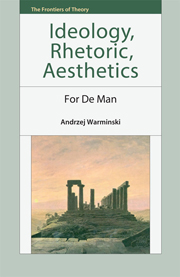Book contents
Appendix 1 - A Question of an Other Order: Deflections of the Straight Man
Published online by Cambridge University Press: 05 October 2013
Summary
Carol Jacobs's admirably subtle and difficult reading dislocates our claustrophobic auditor-reader and leaves him in desperate straits. In the face of such a text – Jacobs's, Kleist's, and Kant's – words like “admirable,” “subtle,” and “difficult” only betray a refusal to read and hence miss the mark entirely. The only way to leave a mark on this text is to read it. And yet the demand for a reading of the text only increases the discomposed auditor-reader's anxiety and places him in an even more embarrassing predicament. Not only is the auditor-reader already inscribed in Jacobs's text (just as the historian and the critic are inscribed in Kleist's text) but his thrusts are parried and his feints met only by an impassive (and ironic) motionlessness: whether we run to the past or to the future “in the hope of escaping the text through another sort of Geschichte and another sort of Kritik,” we find them “already included and ironized within the text.” Whatever our critical stance, it is always somehow the same story. Indeed, we are in a position similar to that of the fencer in the third story of Kleist's “Über das Marionettentheater.” After having soundly defeated Mr von G's son, the fencer (Mr C, the narrator's interlocutor) is led to the wood-shed to meet his master: a bear standing on his hind legs and leaning against the post to which he is tied.
- Type
- Chapter
- Information
- Ideology, Rhetoric, AestheticsFor De Man, pp. 203 - 214Publisher: Edinburgh University PressPrint publication year: 2013



